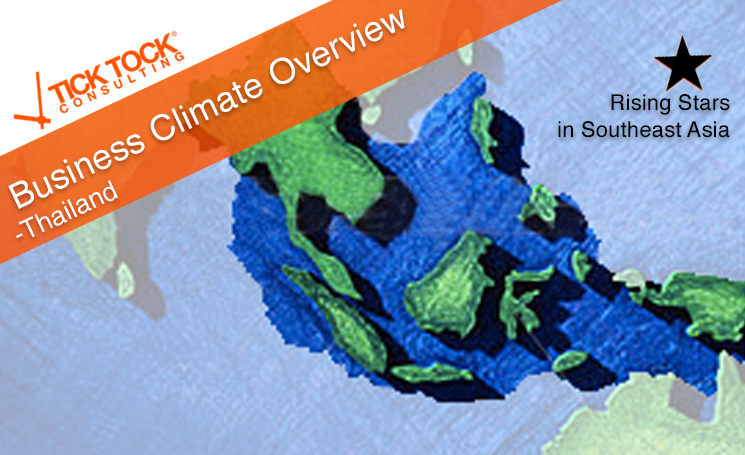Thailand is the second largest economy in Southeast Asia, after Indonesia. It has been ranked among the top 46th in the world and the third among ASEAN countries on the ease of doing business by the World Bank Group. Moreover, geographically, Thailand situated in the middle of ASEAN with excellent infrastructure, Thailand has a potential to be a logistics hub of Asia.
Thailand overview
As a member of ASEAN, investors in Thailand will benefit the free flow of goods, services, capital and labour within the region. Investors will benefit from market access through the country’s FTAs with Japan, China, India, Australia and New Zealand.
Moreover, Thailand has signed many bilateral agreements with many countries such as Australia, Japan, New Zealand and Peru. There are also some FTA negotiations on going.
- Thailand-EU Free Trade Area
- Thailand – European Free Trade Association: EFTA
- Thailand – Turkey
- Thailand – Canada
Apart from Free Trade Agreements with many countries, which will reduce or eliminate import duties, Thailand has agreed with 56 countries on Double Tax agreement (DTA). The focus of a DTA is the elimination of double taxation which applies to only income taxes, namely personal income tax, corporate income tax and petroleum income tax.
| Area | 513,120 sq km |
| Population | Approx. 68.2 million (July 2016) Population in the working age approx. 38.45 million (2016) |
| Capital city | Bangkok |
| Major cities | Bangkok, Phuket, Nakhon Ratchasima, Khon Kaen, Chiang Mai, Chonburi |
| Government | Constitutional monarchy (currently under martial law) Elections are tentatively set for mid-2017. |
| Language | Thai English is a secondary language of the elite (2010 est.) |
| GDP | GDP 1.161 trillion USD (2016 est.) GDP per capita: 16,800 USD (2016 est.) Real growth rate 3.2% (2016) |
| FDI | 12.6 billion USD (net inflow), the 5th largest FDI recipient in East and South-East Asia |
| Unemployment | 0.9% (2016 est.) |
| Minimum wage | 300 baht (10 USD) per day |
| Tax rate | Corporate tax upto 30% , VAT 7% |
| Public debt | 50.4 % of GDP |
| Inflation rate | 0.2% (2016 est.), -0.9% (2015 est.), 1.9% (2014 est.) |
| Export | 190 BUSD (2016 est.), 214.8 BUSD (2015 est.) |
| Import | 171.3 BUSD (2015 est.), 196.4 BUSD (2015 est.) |
Key infrastructure
Thailand’s cabinet approved an infrastructure action plan 25.2 billion USD for 2017 which includes 36 infrastructure projects throughout Thailand.
| There are 38 airports, including 7 international airports. |
| 6 deep sea ports and 2 international river ports, including containers, tank farms and liquid jetties. |
| Railway are connected between regions. There are transportation projects of dual truck railway within 2020. |
| Road standard will be upgrade to ASEAN class. |
| High Speed Internet connection in big cities, Broadband penetration is 9.52% per population and 39,466,260 internet users. (2015) |
| 4G mobile network and mobile subscriptions 123.52% of population. (2014) |
Increasing purchasing power
Since 2013, Thailand’s minimum wage raised and becoming a middle and upper income country. Thailand might not be the cheapest place in ASEAN to outsource anymore. However, increasing of minimum wage means better standard of living and luxury goods are affordable. Thailand is a big market to explore.
Even though labour cost is rising, well developed infrastructure and skilled labours are an advantage for Thailand. Many manufacturers are operating in the market for a long time. They are well established with international trade experiences.
Challenges in the market
- Language barrier: Language could be a challenge to do business with Thai. English is a secondary language of the elite. From interviews with companies they agreed that English proficiency in Thailand is quite low compare to other Asian countries. Top management level could speak very good English. Administrative and technical workers could have problem in communication, however, it’s not impossible to find a good english speaking worker.
- Cultural differences: From our experience in the market, understanding culture different and company’s hierarchy and senior system is very important. Thai likes to build a relationship before start doing the business. Thai prefer face-to-face meeting rather than telephone or video conference. To get through a gatekeeper is quite difficult, knowing someone inside always make process goes faster.
- Corruption: Thailand ranked 101 from 1176 countries in Corruption Perceptions Index (2016) with score 35 by Transparency International. Countries with score higher than 50 were considered as relatively clean from corruption. This is another challenge for investors. Thai government is aimed to increase their efficiency and transparency in budgetary spending, careful auditing, and effective implementation of projects and schemes for public benefit.top Export/import industries in Thailand
| Top Export products 2016 | Top Import products 2016 |
| 1 Motor cars, parts and accessories 2 Computer parts and devices 3 Precious stones and jewellery 4 Electronic integrated circuits 5 Plastic beads 6 Machinery and parts thereof 7 Rubber products 8 Chemical products 9 Petroleum products 10 Iron and steel and their products | 1 Machinery and parts 2 Crude oil 3 Electrical machinery and parts 4 Chemical products 5 Iron and Iron products 6 Automotive parts 7 Electronic circuit 8 Jewelry, stones, silver and gold 9 Computer and parts 10 Metal ore and others |
| Source: Ministry of Commerce |
Based on our analysis and interviews, we decided to narrow down the focus to cover few industries that have strongest potential for EU companies.
Rising Stars in Southeast Asia – Business Opportunity Analysis

